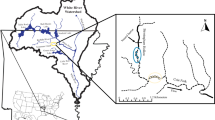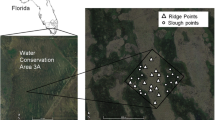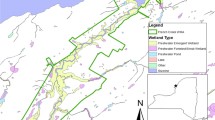Abstract
We examined the hypothesis that secondary production of a community of stream crayfish (Orconectes spp.) depended upon the available suite of channel units (e.g., riffle, run, pool) and that age-specific use of channel units was the important underlying mechanism. Nine cohorts of each of three species over a 10-year period at two sites on the Jacks Fork River, Missouri, USA, were sampled. Cohort-production estimates were calculated for specific channel units: riffles, runs, pools, backwaters and emergent vegetation patches. Orconectes luteus was the most productive species with similar production across channel units. Production of O. ozarkae and O. punctimanus was significantly greater in vegetation patches than other channel units. There were no species by channel unit differences in production between the two sites. Although total site production for some species substantially changed over the 10-year period, relative production differences between habitats remained temporally stable. Differences in mean production between channel units were largely due to age-class habitat use rather than differences related to growth. Some channel units particularly susceptible to common anthropogenic activities that result in hydrograph alterations and homogenization of physical habitat, e.g., backwaters, vegetation patches, and pools, were particularly important as high production areas for two species. A variety of channel units appears necessary for maintaining the high secondary production and diversity of crayfish in this system.






Similar content being viewed by others
References
Benke, A. C., 1984. Secondary Production of Aquatic Insects. In Resh, V. H. & D. M. Rosenberg (eds), Ecology of Aquatic Insects. Praeger, New York: 289–322.
DiStefano, R. J., 2005. Trophic interactions between Missouri Ozarks stream crayfish communities and sport fish predators: increased abundance and size structure of predators cause little change in crayfish community densities. Missouri Department of Conservation, Dingell–Johnson Project F-1-R-054, Study S-41, Job 4, Final Report. Columbia, Missouri.
DiStefano, R. J., J. J. Decoske, T. M. Vangilder & L. S. Barnes, 2003a. Macrohabitat partitioning among three crayfish species in two Missouri streams. USA Crustaceana 76: 343–362.
DiStefano, R. J., C. F. Gale, B. A. Wagner & R. D. Zweifel, 2003b. A sampling method to assess lotic crayfish communities. Journal of Crustacean Biology 23: 678–690.
Garvey, J. E., R. A. Stein & H. M. Thomas, 1994. Assessing how fish predation and interspecific prey competition influence a crayfish assemblage. Ecology 75: 572–574.
Gorman, O. T. & J. R. Karr, 1978. Habitat structure and stream fish communities. Ecology 59: 507–515.
Huryn, A. D. & J. B. Wallace, 1987a. Local geomorphology as a determinant of macrofaunal production in a mountain stream. Ecology 68: 1932–1942.
Huryn, A. D. & J. B. Wallace, 1987b. Production and litter processing by crayfish in an Appalachian mountain stream. Freshwater Biology 18: 277–286.
Ivlev, V. S., 1961. The biological productivity of waters (English version 1966). Journal of the Fisheries Research Board of Canada 23: 1727–1759.
Jacobson, R. B. & A. T. Primm, 1994. Historical land-use changes and potential effects on stream disturbance in the Ozark Plateaus, Missouri. US Geological Survey Open File Report 94–333. Rolla, Missouri.
Mason, J. C., 1975. Crayfish production in a small woodland stream. Freshwater Crayfish 2: 449–480.
Mitchell, D. J. & L. A. Smock, 1991. Distribution, life history and production of crayfish in the James River, Virginia. American Midland Naturalist 126: 353–363.
Momot, W. T., 1984. Crayfish production: a reflection of community energetics. Journal of Crustacean Biology 4: 35–54.
Momot, W. T., 1995. Redefining the role of crayfish in aquatic ecosystems. Reviews in Fisheries Science 3: 33–63.
Momot, W. T., H. Gowing & P. D. Jones, 1978. The dynamics of crayfish and their role in ecosystems. American Midland Naturalist 99: 10–35.
Penfound, W. T., 1940. The biology of Dianthera americana L. American Midland Naturalist 24: 242–247.
Rabeni, C. F., 1985. Habitat partitioning by stream-dwelling crayfish: the influence of body size. American Midland Naturalist 113: 20–29.
Rabeni, C. F., 1992. Trophic linkages between centrarchids and their crayfish prey. Canadian Journal of Fisheries and Aquatic Sciences 49: 1714–1721.
Rabeni, C. F. & R. B. Jacobson, 1993. The importance of fluvial hydraulics to fish habitat in low gradient alluvial streams. Freshwater Biology 29: 211–220.
Rabeni, C. F., M. Gossett & D. D. McClendon, 1995. The contribution of crayfish to the invertebrate production and trophic ecology of an Ozark stream. Freshwater Crayfish 10: 163–173.
Ricker, W. E., 1975. Computation and interpretation of biological statistics of fish populations. Bulletin 191 of the Fisheries Research Board of Canada, Department of the Environment, Fisheries and Marine Service, Ottawa. 382.
Roell, M. J. & D. J. Orth, 1992. Production of three crayfish populations in the New River of West Virginia, USA. Hydrobiologia 228: 185–194.
SAS Institute Inc., 2000. SAS/STAT user’s guide, version 8th edition. SAS Institute. Inc, Cary, North Carolina.
Whitledge, G. W. & C. F. Rabeni, 1997a. Diel and seasonal variation in food habits of crayfishes in a Missouri Ozark stream. Freshwater Crayfish 11: 159–169.
Whitledge, G. W. & C. F. Rabeni, 1997b. Energy sources and ecological role of crayfishes in an Ozark stream: insights from stable isotopes and gut analysis. Canadian Journal of Fisheries and Aquatic Sciences 54: 2555–2563.
Whitmore, N. & A. D. Huryn, 1999. Life history and production of Paranephrops zealandicus in a forest stream with comments about the sustainable harvest of freshwater crayfish. Freshwater Biology 42: 467–478.
Acknowledgments
This research is a contribution of the Missouri Cooperative Fish and Wildlife Research Unit (US Geological Survey, Missouri Department of Conservation, University of Missouri, and Wildlife Management Institute cooperating). Major funding was provided by the Missouri Department of Conservation. We thank the numerous field technicians for assistance with crayfish collection. The manuscript was improved by comments from Jacob Westhoff, Ann Allert, and two anonymous reviewers.
Author information
Authors and Affiliations
Corresponding author
Additional information
Handling editor: D. Dudgeon
Rights and permissions
About this article
Cite this article
Brewer, S.K., DiStefano, R.J. & Rabeni, C.F. The influence of age-specific habitat selection by a stream crayfish community (Orconectes spp.) on secondary production. Hydrobiologia 619, 1–10 (2009). https://doi.org/10.1007/s10750-008-9577-8
Received:
Revised:
Accepted:
Published:
Issue Date:
DOI: https://doi.org/10.1007/s10750-008-9577-8




